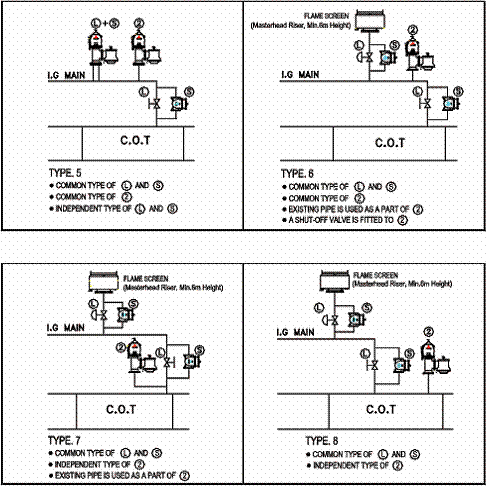

¢º Benefits of NEW-ISO-HV series
-
Easy full stroke check lifting
-
Visible P / V disc operating position
-
No accumulation of vapor & liquid
-
No deck pollution due to spill-over of liquid & vapor
-
No hammering -Easy replaceable structure
-
Complies of IMO MSC/Circ. 677
-
Comply with ISO standard 15364
-
Meets vapor control system of USCG
-
Approved by the administrations
-
Approved by classification societies
The Marine Safety Committee approved amendments to paragraph 1.2.4 of the Revised standards for design, testing and locating of devices to prevent the passage of flame into cargo tanks in tankers (MSC/Circ.677), as follows :
"1.2.4 Devices should be tested and located in accordance with these standards. In addition to these standards, pressure/vacuum valves should comply with ISO standard 15364:2000 " Ships and marine technology - Pressure/vacuum valves for cargo tanks".
The ISO standard requires that valves are fitted with a device to indicate its position. And, the Maritime Safety Committee agreed that this does not mean an indicator has to be fitted but that the position of the valve should be visually understood in any way.¢º Visible P/V disc operating position


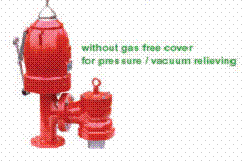
Purpose
NEW-ISO-HV series high velocity pressure / vacuum valve is designed to prevent the flame passage into cargo tanks and to relieve excessive over pressure or under vacuum of cargo tanks during cargo loading, discharging, ballasting and thermal variations.
Also, our valve could be used to device for gas freeing of cargo tanks and for preventing penetration of sea water into water ballast tanks during valve and deck are submerged under seawater level due to vessel's rolling, pitching and stranding in case of installation on ballast tank.
¡¡
for gas free cover of cargo tank

Our NEW-ISO-HV series high velocity pressure/vacuum valves could be used with portable gas free cover series valve at its outlet top. So it is beneficial to cut down extra weight and deck space of pipe spool for gas free cover.
¡¡
for water ballast tanks
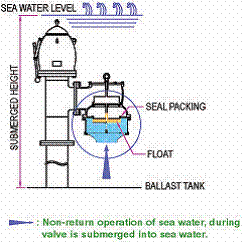
Operation
New-ISO-HV series
could be installed on water ballast tanks when ballast tank is inserted.
In case of
valve's submerging under the sea water due to rolling, pitching and stranding,
this valve is designed to prevent penetration of sea water into ballast tanks.
Although the NEW-ISO-HV series high velocity valve is submerged under sea water,
sea water is not penetrated into water ballast tank due to closing of pressure
disc and tightness of float on vacuum side.
This arrangement could be reduced ship dead weight and complex piping system
without extension vent pipe near ship center.
¡¡
¢º Outline DrawingTank venting systems should be designed and operated so as to ensure that neither pressure nor vacuum created in the cargo tanks during or unloading exceeds tank design parameters. The main factors to be considered in the sizing of a tank venting system are as follows :
- design loading and unloading rate ;
- gas evolution during loading : this should be taken account of by multipliying the maximum loading rate by a factor of at least 1.25 ;
- density of the cargo vapour mixture ;
- pressure loss in vent piping and across valves and fittings ;
- pressure / vacuum settings of relief devices.


-
SOLAS Chap. ¥±-2. Reg. 59.1.2.3 (added)
A secondary means of allowing full flow relief of vapor, air or inert gas mixtures to prevent over-pressure or under-pressure in the event of failure of the arrangements in SOLAS Reg. 59. 1.2.2.
- SOLAS Chap. ¥±-2. Reg. 59.1.3.2 (replaced)
Where the arrangements are combined with other tanks, either stop valves or other acceptable means shall be provided to isolate each cargo tank. Where stop valves are fitted, they shall be provided with locking arrangements which shall be under the control of the responsible ship's officer. There shall be a clear visual indication of the operational status of the valves or other acceptable means. Where tanks have been isolated, it shall be ensured that relevant isolating valves are opened before cargo loading or ballasting or discharging of those tanks is commenced. Any isolation must continue to permit the flow caused by thermal variations in a cargo tank in accordance with paragraph SOLAS Reg. 59. 1.2.1.
- SOLAS Chap. ¥±-2. Reg. 59.1.3.3 (added)
If cargo loading and ballasting or discharging of a cargo tank or cargo tank group is intended, which is isolated from a common venting system, that cargo tank or cargo tank group shall be fitted with a means for over-pressure or under-pressure protection as required in paragraph SOLAS Reg. 59. 1.2.3.
- SOLAS Chap. ¥±-2. Reg. 59.1.11 (added)
Ships constructed before 1 July 1998 shall comply with the requirements of paragraphs 1.2.3 and by the date of the first scheduled dry-docking after 1 July 1998, but nor later than 1 July 2001.
- MSC/Circ.929 & MEPC/Circ. 362
The Maritime Safety Committee (MSC) and the Marine Environment Protection Committee (MEPC) approved the following interpretation for paragraph 8.1.5 of the IBC Code and part E of chapter ¥± of the BCH Code to cover the application of cargo-tank venting requirements for combined chemical/oil tankers and chemical tankers ;
"The relevant provisions for controlled tank venting systems contained in chapter 8 of the IBC Code and chapter ¥± of the BCH Code should be applied to combined chemical/oil tankers and chemical tankers in lieu of the requirements of SOLAS regulation ¥±-2./59.1." Also, the MEPC adopt the following revised rule requirements of IBC and BCH Code for a secondary means of allowing full flow relief of vapor, air or inert gas mixtures to prevent over-pressure or under-pressure in the event of failure of a primary means. The following revised rule will be forced from 1 July2002.
"Combined oil/chemical tankers and chemical tankers constructed after 1 July 2002 shall comply with the above revised rule. Also, combined oil/chemical tankers and chemical tankers constructed before 1 July 2002 shall comply with the above revised rule by the date of the first scheduled dry-docking after 1 July 2002, but nor later than 1 July 2005."

The 1996 Amendments to SOLAS introduce new requirements to cargo tank venting systems for oil tankers and chemical tankers. In substance the new requirements call for double pressure vacuum protection of cargo tanks during loading, discharging and ballasting. The primary as well as secondary means for p/v protection may be fitted to each cargo tank or in a common venting system or divided, e.g. primary means in a common system and secondary means fitted to cash cargo tank as followings.
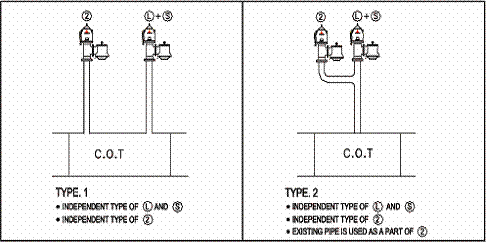
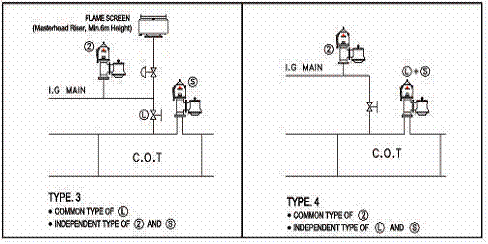
¢º Examples of acceptable venting arrangements
